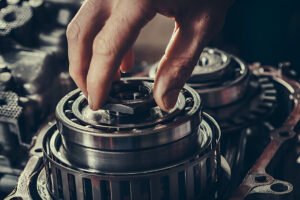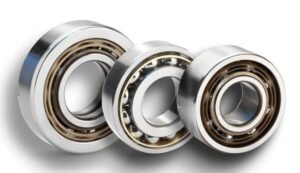The high-performance bearing types are important in machinery. Along with ball bearings, angular contact ball bearings are one of the most commonly and reliably used bearing types in machinery with rolling element bearings. These bearings are beneficial when the load conditions require radial loads with axial loads.
In the following guide, we will look at the combinations of angular contact ball bearings and their potential applications to assist with selecting the best solution to suit your machinery.
Table of Contents
What are Angular Contact Ball Bearings?
Angular contact ball bearings allow you to support radial and axial loads at the same time with more rigidity. An angular contact ball bearing has an inner and outer ring, with a set of balls that are designed at an angle to the bearing axis. The angular design of angular contact ball bearings is useful as it allows companies to support combined loads.
Moreover, they provide higher stiffness, precision, and high speeds. Angular contact ball bearings come in a variety of combinations of single-row, double-row, and paired angular contact, and they have different design features and capabilities depending on the application.
Key Features of Angular Contact Ball Bearings
Load Carrying Capacity: Angular contact ball bearings allow you to carry radial and axial loads.
Precision and Speed: Angular contact ball bearings are intended to be used in high speeds and low friction.
Low Operating Temperature: Excellent performance at elevated speeds and temperatures.
Axial Load Capabilities: Can support axial loads greater than conventional radial ball bearings.
Angular Contact Ball Bearings Combinations

1. Single Row Angular Contact Ball Bearings
Single row angular contact ball bearings are the most common type of angular contact ball bearings. They consist of one row of balls supporting radial as well as axial loads but in only one direction. An axial load creates a contact angle that can vary depending on the application.
Applications: Single row angular contact ball bearings are recommended for any application where an axial load is moderate and unidirectional. Examples – electric motors, machine tools, and automobile steering.
2. Paired Angular Contact Ball Bearings
Paired angular contact ball bearings consist of a set of two or more bearings that are assembled in a way that supports axial loads in both directions. The configurations can either be back-to-back (DB), face-to-face (DF), or tandem (DT).
Back-to-Back (DB) Pair
Description: A Back-to-Back (DB) arrangement has the bearings with the contact angles facing away from one another, allowing the system to support axial loads in both directions.
Applications: Common applications include spindles, gearboxes, and machine tool stations where axial load balancing is critical. Back-to-back arrangements of paired angular contact ball bearings usually offer high rigidity and accuracy and can be found in machines like printers and CNC equipment.

Face-to-Face (DF) Pair
Description: An assembly of angular contact bearings in which the contact angles are facing towards each other could be termed a Face-to-Face (DF) arrangement. This allows the assembly to support radial loads while accommodating axial loads in both directions.
Applications: DP is the preferred arrangement in applications where the shaft’s axial displacement should be accommodated while supporting a radial load, e.g., pumps and electric motors. DF is also found in moderate axial load applications that do not require extreme precision, but the axial displacement capability is not an acceptable trade-off.
Tandem (DT) Pair
Description: This set-up consists of bearings with the same contact angle arranged in a series to provide as uniform a load distribution as possible.
Applications: These are typically found used in high-speed turbines or roller bearings and particularly when one direction of the axial load is more. They can also be found in all applications where ultra-high speeds are requirement such as in sports equipment, cycling hubs, and racing vehicles.

3. Double-Row Angular Contact Ball Bearings
Double-row angular contact ball bearings have two rows of balls arranged in one bearing. double-row angular contact ball bearings can accommodate both radial and axial load, both directions, and used for higher load capacities than single-row variations.
Applications: Dual-row angular contact ball bearings are used in applications requiring greater load-carrying capacities and requiring both radial and axial loads. Throughout the industry, they are mostly used in automotive wheel hubs, pumps used in motors, and electrical generators.
4. Four-Point Contact Ball Bearings
Four-point contact ball bearings are a type of angular contact ball bearing, capable of supporting both radial and axial loads in either direction. As a one-row bearing with two contact points per ball, a four-point contact ball bearing is a compact solution that aims to support very high loads and radial loads.
Applications: You will find these bearings in applications such as turntable systems, solar tracking systems and very large devices and machines where rotational motion is vital for operational control. They are designed for loads that will apply both axial and radial loads, but in limited radial spaces.
Choosing the Right Forces, Speed, Precision, Space, and Combination in Angular Contact Ball Bearing Applications

Selecting the correct combination of angular contact ball bearings will require analysis of the application and its requirements, including loading type, speed of operation, precision level, and subsequent axial demands, and of course, any space constraints. The following is a simplified overview to select the proper combination:
Load Type and Direction: Attain and determine if the axial load is unidirectional or bidirectional. This will dictate if you should have a single-row configuration or paired configuration with the single-row layout, two-rows or combined arrangements.
Speed and Temperature: High-speed applications will require bearings that operate at low friction and temperatures. This can be influenced by the contact angle in conditions of high speed load, as the bearing’s contact angle has to be increased to reach higher speed loads.
Rigidity and Precision: When considering machinery for high precision, typically found in single-direction applications such as NC machines and robotics, the best configuration may be a paired arrangement with back-to-back (DB) to maximize rigidity and stability.
Available Space: If space is limited then the four-point contact ball bearings or single-row bearings can be the ideal configurations to use. These both are designed to limit space and weight while increasing the performance.
Typical Uses of Angular Contact Ball Bearings
Machine Tools: Angular contact ball bearings are usually found in machine tool spindles, CNC machines, etc. These are used due to their high-speed capabilities and their ability to perform high-speed applications.
Electric Motors: Electric motors need technical bearings capable of radial and axial loading, in high-speed application environments. Single-row and double-row angular contact ball bearings, in general, are typically used in DC motors, AC motors, and Servo motors.
Automotive Industry: In vehicle systems in the automotive world, like wheel hubs and transmissions, an angular contact ball bearing can be used to provide smooth, consistent motion. Double-row angular contact ball bearings are typically used in a vehicle’s wheel hub because they need to be able to withstand significant radial and axial loads.
Aerospace: Angular contact ball bearings are important in the tactical aerospace world. These are commonly used in turbine assemblies, rotors, and in other high-speed components where precision is extremely important, but handling a load is imperative.
Robotics: The use of angular contact ball bearings fashioned into robotic arms allows for very smooth, high-precision movement under the load of the part it is actuating. Today’s advances in robotic arm capabilities help industrial automation become more efficient and effective.
Conclusion
Angular contact ball bearings are important part in any machine that needs to carry axial or radial loads. Whether you are using single-row bearings, double-row bearings, or four-point contact bearings. The right combination is important to maximize the performance and reliability of your machine.
Decent Machinery has a full line of angular contact ball bearings, as per your needs! Our knowledgeable and experienced engineers are available to help assist in finding the right bearings combinations, allowing you to keep your machinery running effectively and efficiently.
If you need professional advice, customized solutions, or want to find out more about angular contact ball bearings, get in touch with Decent Machinery today!




